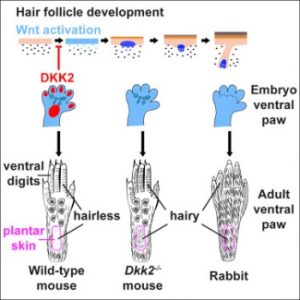Last week, researchers and scientists led by University of Pennsylvania’s Dr. Sarah Millar published a fascinating new open-access journal article titled:
“Regional Control of Hairless versus Hair-Bearing Skin by Dkk2.”
It seems like the researchers were trying to find an answer to an age old question: why don’t humans have hair on their palms and soles?
I always assumed that human beings and most other animals have no hair follicles and dermal papilla cells on their palms and feet/soles.
However, it seems like this is not true. You can get hairy palms and hairy feet based on just one slight genetic alteration (the removal of Dkk2). In fact, some animals such as rabbits and polar bears do have hairy feet/paws due to this very reason.
Dkk2: Remove it if you want Hairy Palms
Dickkopf-related protein 2 (Dkk2) is a protein that is encoded by the Dkk2 gene. This gene, when expressed in the palms and feet, works to inhibit Wnt/β-catenin signaling. This in turn results in totally hairless skin in those regions. The authors term Dkk2 as a Wnt inhibitor.
The Penn Medicine research team that led this latest research found that when they genetically removed Dkk2 expression from the plantar skin of mice, the animals began to sprout hair in this previously hairless area. This was due to the removal of Wnt signal inhibition.
Wnt/β-catenin signaling is crucial for hair growth in any area of the human body, and is the most researched subject area when it comes to the search for a hair loss cure. Not surprisingly, by now I must have written at least 50 posts on this blog in which I at least briefly mention Wnt/β-catenin or Wnt signaling.

10.1016/j.celrep.2018.11.017
Dkk2 and Baldness
According to this article, Some studies have found correlations between baldness and DKK2 levels, but it is unclear whether this relationship is causal in nature.
According to Dr. Millar:
“We’re interested in taking a look at the precise nature in the difference in DKK2 in balding scalps versus normally-haired scalps,” Millar said. “We don’t know the answer yet.”
It is interesting that several companies over the years have worked on products that could both reduce body hair and increase head hair. The most famous of these is Follicum, although the company no longer seems to be working on a body hair reduction product.